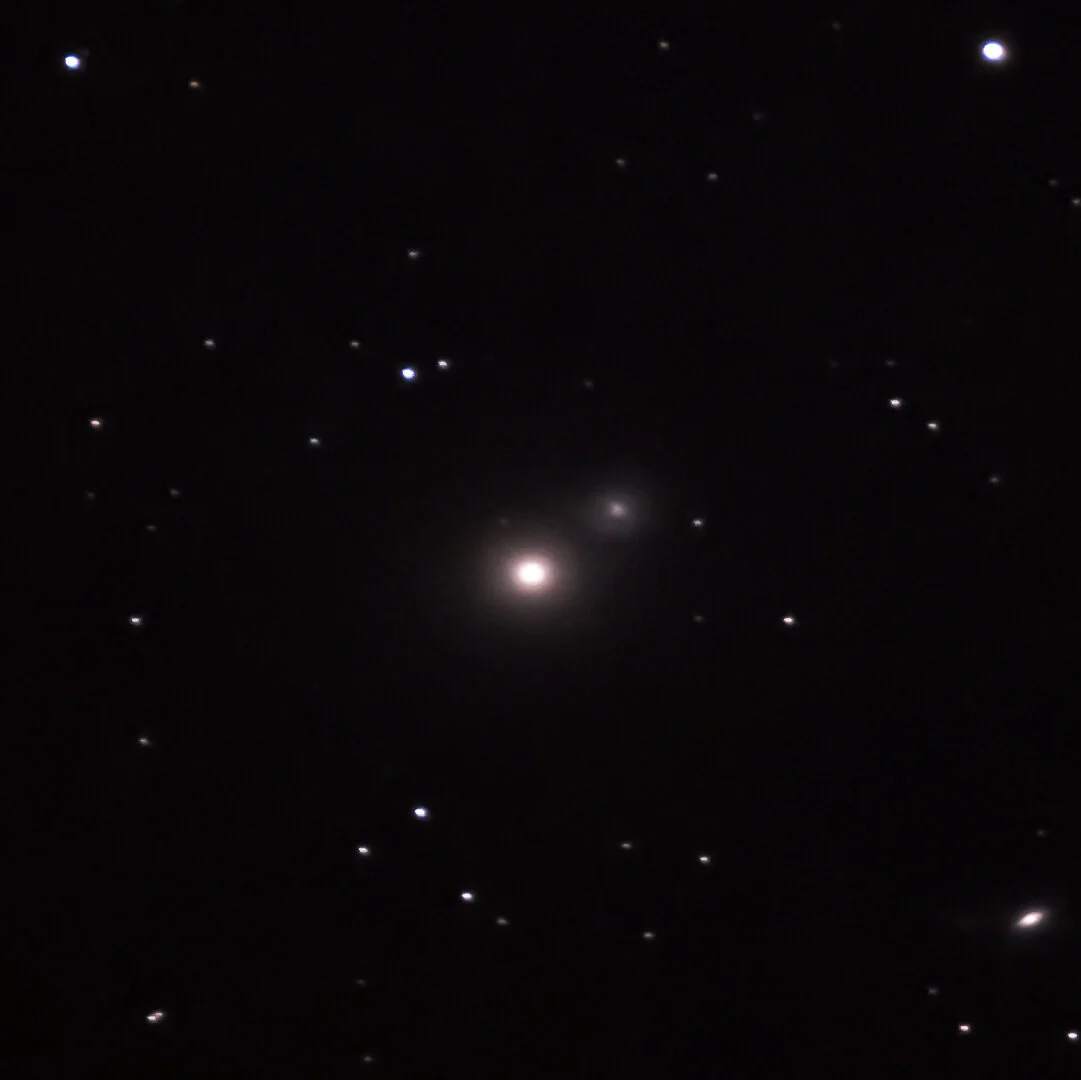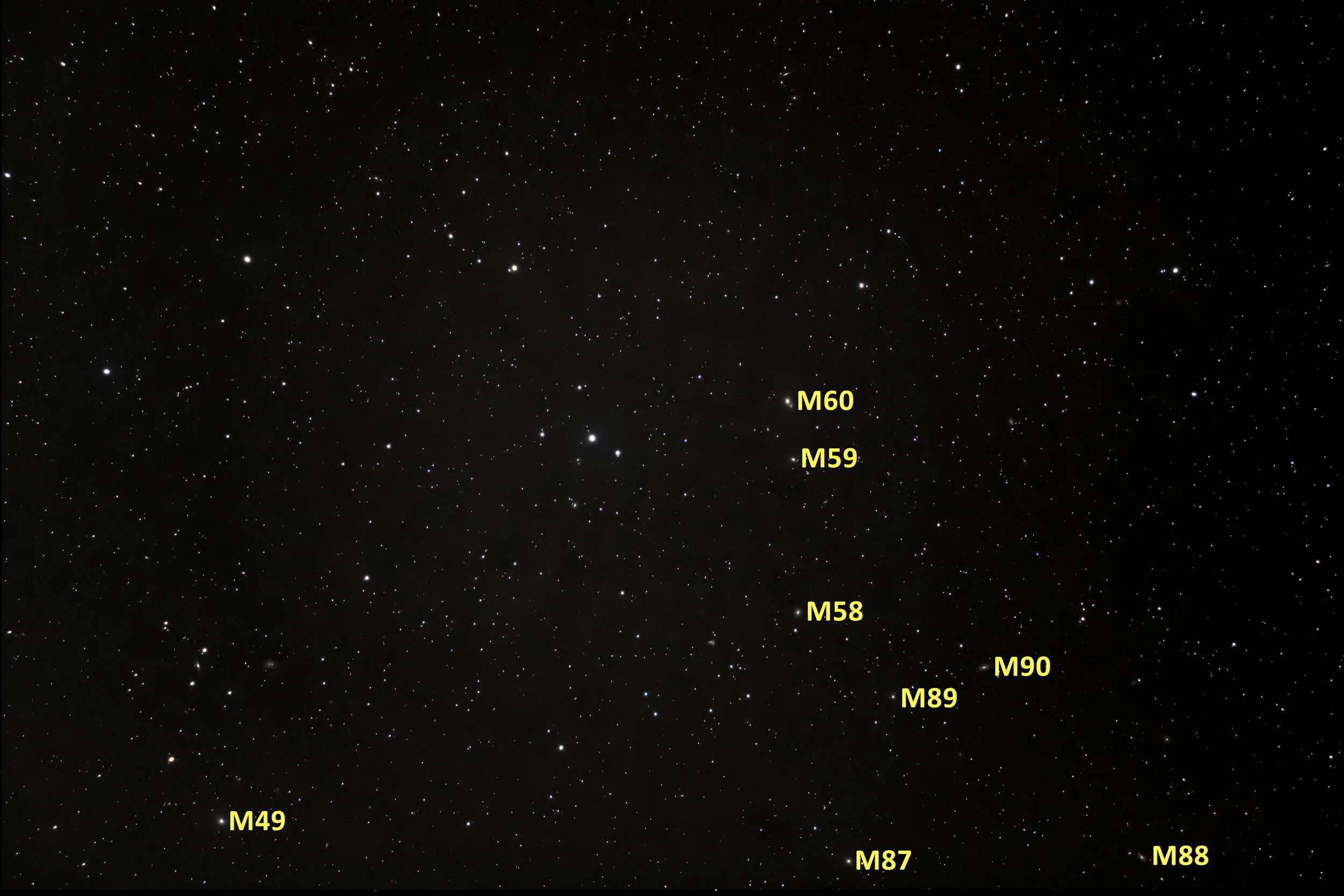M60 - Elliptical Galaxy
Type: Elliptical Galaxy
Discoverer: Johann Gottfried Koehler April 11, 1779
Size: 115,000 ly
Distance: 53 Mly
Constellation: Virgo
Note: M60 is the larger galaxy on the left.
My Notes: There were a lot of user errors tonight capturing this, M59, M58, and M89. First off the good. I tried out a new tripod purchased specifically for stability, the Artcise AS90C carbon fiber tripod. It was rock solid. I’ve never felt so sure about the foundation of my astrophotography setup before. With that said, I was astonished at how hard I was finding it to get the galaxy in focus and not have trails. I specifically went out early to get everything setup in the daylight which makes things so much easier. Once it got dark enough to start to dial in my target and focus in on it, I was having a lot of difficulty. I started by trying to get the wider field of view at 140mm, but anytime I got over 30 seconds of exposure, I would see star trails which makes no sense because I’ve regularly shot for 120 seconds at a time with my star tracker.
After about 30 minutes I realized I didn’t have my star tracker on. I had the tracking camera plugged into the computer, but that doesn’t turn on the spinning gears. So after smacking my head about that dumb mistake I turned it on and tried again. I was then able to get up to about 60 seconds, but anything longer was producing star trails. It was a bit windy, but I didn’t think it should cause this much trouble. I moved my car around to try to block the wind, but still no luck. I was getting a bit disappointed in my new tripod because I expected it would have helped to alleviate this . 60 minutes into trying to focus I remembered that I had my star tracker set to moon speed from a lunar party instead of star speed. So I smacked my forehead again and changed to star speed and then everything was smooth sailing.
I was able to make many fine adjustments without trouble on the solid tripod. I spent a lot of time trying to decide what level of ISO to use since these elliptical galaxies in Virgo are very small, faint, indistinct objects. I settled on 5000, but after editing I think I would have done better to go a step or 2 lower. It wouldn’t make much difference on the objects themselves, but I would have smoother blacks.
I photographed 59 & 60 as a two-fer to knock a couple objects out at once. While that was capturing I realized I only needed to nudge my camera a miniscule amount to get 58. I was tired, but thought I would be stupid not to get another one. I probably would have kept going down the line of galaxies in the Virgo cluster, but it was getting close to the horizon and the atmosphere was already sub par in terms of haze so I decided to call it a night since I figured the quality would be pretty bad. It wasn’t until I got home that I realized I had also captured 89 in the same photos as 58 so I was able to cross 4 objects off tonight.
Aside from my new tripod I used my now standard setup: Fujifilm X-T4, 100-400mm f/4.5-5.6 +1.4x teleconverter, iOptron SkyGuider Pro. Even my ball head wasn’t as annoying to use this time because it was on a firm base. M59 & M60 were captured June 4th, 2021 from 00:10 to 00:48.
Koehler Notes: (April 11th & 13th, 1779) (M59 and M60) “Two very small nebulae, hardly visible in a 3-foot telescope; one above the other.”
Oriani: (April 12th, 1779) “Very pale and looking exactly like the comet."
Messier Notes: (April 15th, 1779) “A nebula in Virgo, a little more distinct than the two preceding (m58 & m59)… Reported on the chart of the comet of 1779. He [Messier] discovered the three nebulae while observing the comet which passed very close to them. The latter passed so near on the 13th and 14th April that they were both in the same field of view and he could not see it. It was not until the 15th, while looking for the comet, that he perceived the nebula. None of the three nebulae appears to contain a star.”
M60. 5 frames at 120 sec Dark Median Algorithm ISO 5000 f/8 560mm (840 FF equiv)
Virgo Galaxy Supercluster with M58 and 10 other Messier Objects among many other galaxies.
8 Messier Objects (galaxies) in one image (Labels are to the right of the object) 140mm focal length (210 FF equiv)
Drawing by Ronald Stoyan




